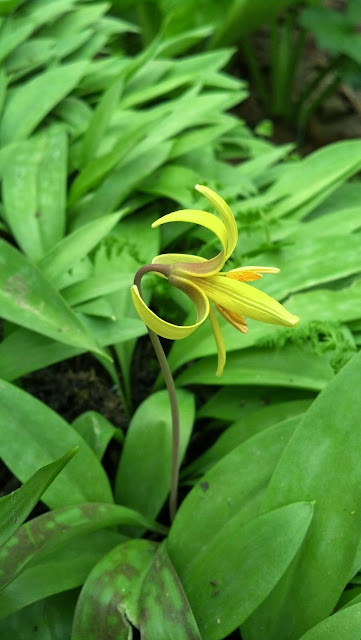3 May 2014
Ashland Nature Center
Today was the first day of the Wildflower Certification Class. We focused on spring ephemerals--flowers that only appear briefly in the beginning of spring. Before we went out into the woods, we went over Newcomb's Guide and practiced with some flowers in the wildflower garden at Ashland.
The three flowers we identified were
Foam flower (tiarella cordifolia)
Wild bleeding heart (Dicentra eximia)
Wild columbine (Aquilegia canadensis)
Basil bee balm (monarda clinopodioides), a member of the mint family
Members of the mint family always have square stems.
---
Next, we headed up Treetop Hill to look for flowers and ferns.
False mermaid weed (Floerkea proserpinacoides)
 |
False mermaid weed
|
Crowfoot buttercups (ranunculis)
 |
| Crowfoot buttercups get their name from the shape of their leaves |
The yellow Trout lily (Erythronium americanum) has a European relative called the Dogtooth Violet, which is pink and white. The Trout Lily reproduces by stolons that run underground.
 |
Trout lily (Erythronium americanum)
|
Jetbead (rhodotypos scandens)
Goldenseal: This plant was heavily harvested for medicinal purposes, so it's now pretty rare.
 |
Goldenseal
|
Ramps (Allium tricoccum) are related to onions and garlic. They're hard to find, so we only sampled a tiny piece. They taste like garlic.
We frequently saw Arrowwood (viburnum dentatum), which got its name because it was used by some Native American tribes to make arrows.
 |
| Arrowwood |
Early saxifrage
Cut-leaf toothwort (cardamine concatenata) is in the mustard family. All mustards have four-part flowers.
 |
Cut-leaved toothwort
|
Bluets, also called Quaker Ladies, are another spring ephemeral.
 |
Bluets (Houstonia caerulea)
|
Ivy-leaved speedwell (veronica hederofolia) was growing at the top of the hill. This is a non-native plant.
Blue cohosh (caulophyllum thalictroides) is used as a childbirth aid.
 |
| A not very clear picture of blue cohosh (on the right) |
Jack-in-the-pulpit grows on moist forest floors. The "jack" is the spadix (spike inflorescence). It has a relative called the Green Dragon with a long spadix that extends like a dragon's tongue.
 |
Jack-in-the-pulpit (Arisaema triphyllum)
|
Bloodroot (sanguinaria canadensis) is one of the earliest-blooming spring ephemerals. It gets its name because the root is the color of raw steak when you cut into it:
 |
Bloodroot root!
|
 |
Bloodroot leaf
|
And the flower had already come and gone by the time we saw the plant. But here's a picture of the flower from the middle of April:
 |
Bloodroot flower, Middle Run, April 15
|
 |
| Downy yellow violet (Viola pubescens)--the one we found is actually a variety with smooth instead of hairy leaves |
 | ||
Spring beauty
|
 |
Virginia water leaf
|
 |
| Bellwort |
Besides spring wildflowers, we saw several ferns.
 |
| Not exactly sure what kind of fern this is |
 | ||
Christmas Fern
|
This garter snake (thamnophis sirtalis) was taking nap in the sun and did not want to be bothered.
 |
| Not a flower |
 |
| View from the top of the hill |


nice pictures - we saw a bunch of (now i know) trout lilies in white clay creek.
ReplyDeleteThanks! That one was my favorite.
ReplyDelete